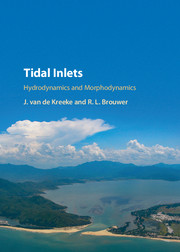Book contents
- Frontmatter
- Contents
- Preface
- 1 Introduction
- 2 Geomorphology
- 3 Sand Transport Pathways
- 4 Sand Transport and Sand Bypassing at Selected Inlets
- 5 Empirical Relationships
- 6 Tidal Inlet Hydrodynamics; Excluding Depth Variations with Tidal Stage
- 7 Tidal Inlet Hydrodynamics; Including Depth Variations with Tidal Stage
- 8 Cross-Sectional Stability of a Single Inlet System
- 9 Cross-Sectional Stability of a Double Inlet System, Assuming a Uniformly Varying Basin Water Level
- 10 Cross-Sectional Stability of a Double Inlet System, Assuming a Spatially Varying Basin Water Level
- 11 Morphodynamic Modeling of Tidal Inlets Using a Process-Based Simulation Model
- 12 Morphodynamic Modeling of Tidal Inlets Using an Empirical Model
- 13 River Flow and Entrance Stability
- 14 Engineering of Tidal Inlets
- References
- Index
11 - Morphodynamic Modeling of Tidal Inlets Using a Process-Based Simulation Model
Published online by Cambridge University Press: 04 July 2017
- Frontmatter
- Contents
- Preface
- 1 Introduction
- 2 Geomorphology
- 3 Sand Transport Pathways
- 4 Sand Transport and Sand Bypassing at Selected Inlets
- 5 Empirical Relationships
- 6 Tidal Inlet Hydrodynamics; Excluding Depth Variations with Tidal Stage
- 7 Tidal Inlet Hydrodynamics; Including Depth Variations with Tidal Stage
- 8 Cross-Sectional Stability of a Single Inlet System
- 9 Cross-Sectional Stability of a Double Inlet System, Assuming a Uniformly Varying Basin Water Level
- 10 Cross-Sectional Stability of a Double Inlet System, Assuming a Spatially Varying Basin Water Level
- 11 Morphodynamic Modeling of Tidal Inlets Using a Process-Based Simulation Model
- 12 Morphodynamic Modeling of Tidal Inlets Using an Empirical Model
- 13 River Flow and Entrance Stability
- 14 Engineering of Tidal Inlets
- References
- Index
Summary
Introduction
Morphodynamic models come in two categories. Based on their architecture a distinction is made between process-based models and empirical models. In the present chapter the focus is on process-based modeling. Process-based models start with small-scale physics and integrate the results over the larger timescales. Because at this time the state of the art of process-based modeling limits the time period over which can be integrated, most model applications focus on problems with timescales of months to decades. Examples are the adaptation of the inlet cross-section after a storm, the formation of an ebb delta after the opening of a new inlet, migration and breaching of channels and spit formation (Nahon et al., 2012; Tung et al., 2012; van der Wegen et al., 2010). To address problems with larger timescales, parallel to the process-based models, empirical models have been developed. They are the subject of Chapter 12. A common characteristic of process-based and empirical morphodynamic models is the feedback between morphology (bathymetry) and hydrodynamics; the hydrodynamics causes a change in bathymetry and in turn this affects the hydrodynamics.
Model Concept and Formulation
Process-based morphodynamic models consist of a series of computational modules as shown in Fig. 11.1. Starting with a known bathymetry and water level boundary conditions, the hydrodynamic equations (Lesser et al., 2004) are solved in the Flow module. Given the wave boundary conditions, wave transformation including wave height and direction is calculated in the Waves module. To account for tidal stage and wave-current interaction, information on water levels and current velocities is transferred from the Flow to the Waves module. Radiation stresses are calculated and the results are transferred to the Flow module. Exchange between the two modules takes place at specified time intervals.
In general this interval is much larger than the computational time step used in either of the modules. Using the information on currents and waves from the Flow and Waves modules, sediment transport is calculated in the Sediment Transport module using selected sediment transport formulae. With the results of the sand transport calculations the bathymetry is updated in the Bathymetry module.
Information
- Type
- Chapter
- Information
- Tidal InletsHydrodynamics and Morphodynamics, pp. 110 - 119Publisher: Cambridge University PressPrint publication year: 2017
